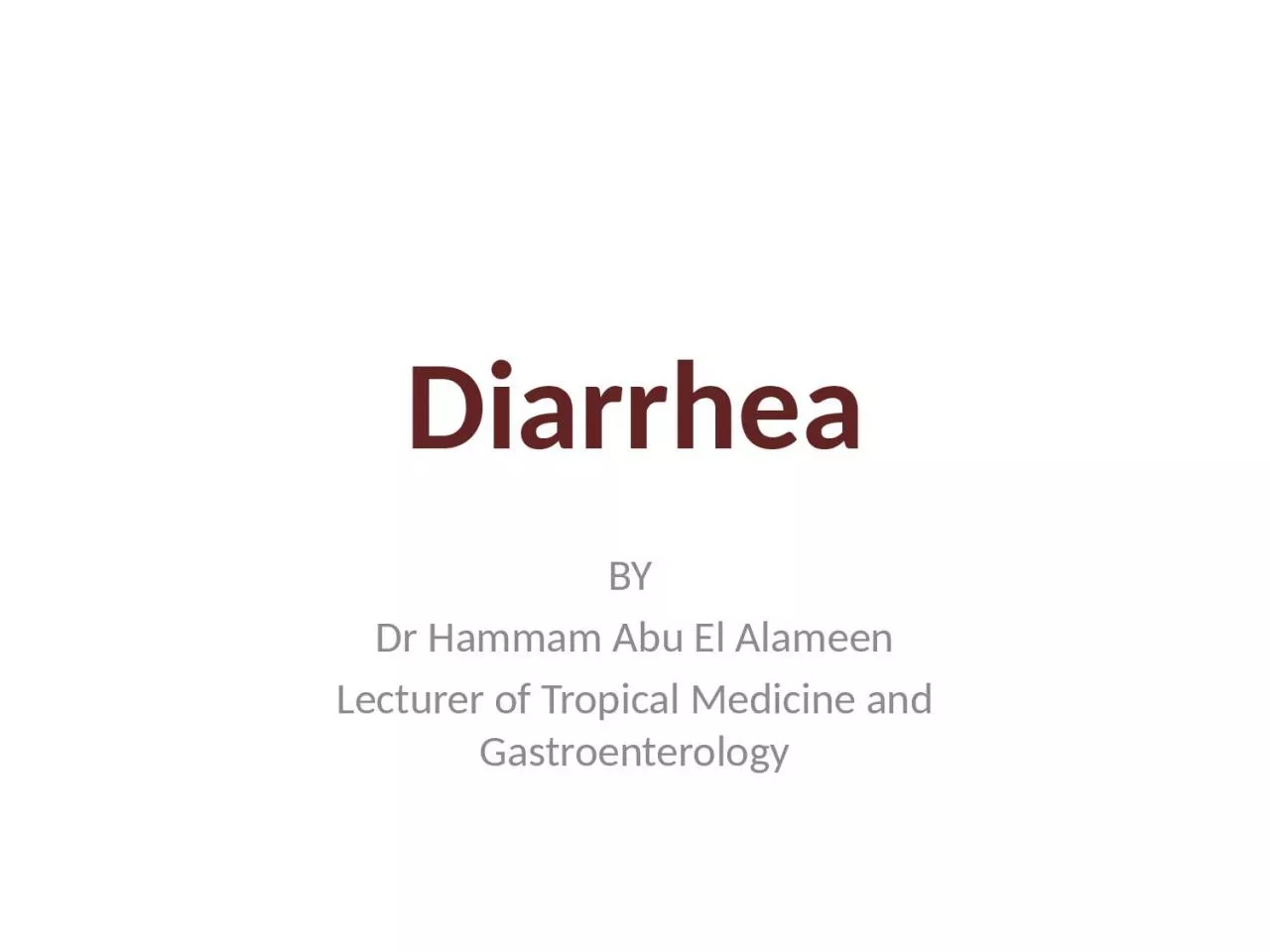

Abu El Alameen Lecturer of Tropical Medicine and Gastroenterology Diarrhea Definition It is an increase in frequency and liquidity of stools Types Acute diarrhea Chronic diarrhea ID: 1045247
Download Presentation The PPT/PDF document "Diarrhea BY Dr Hammam" is the property of its rightful owner. Permission is granted to download and print the materials on this web site for personal, non-commercial use only, and to display it on your personal computer provided you do not modify the materials and that you retain all copyright notices contained in the materials. By downloading content from our website, you accept the terms of this agreement.
1. DiarrheaBY Dr Hammam Abu El AlameenLecturer of Tropical Medicine and Gastroenterology
2. Diarrhea Definition:It is an increase in frequency and liquidity of stools. Types:Acute diarrhea.Chronic diarrhea.
3. Acute diarrheait is with acute onset and present for less than 3weeks and is sub classified into:Non-inflammatory Diarrhea: Watery, non-bloody diarrhea associated with peri-umbilical cramps, bloating, nausea, or vomiting may be voluminous and result in dehydration, no fever or evidence of blood or fecal leucocytes.
4. Acute diarrheaIt may be due to:Toxin-producing bacteria [enterotoxigenic Escherichia coli (ETEC), Staphylococcus aureus, Bacillus cereus, Clostridium perfringens, V.cholera].Viral infections: Rota virus and Norwalk virus.Protozoal infections: Giardia and cryptosporidium.
5. Acute diarrheaInflammatory Diarrhea: often associated with systemic symptoms including fever, bloody diarrhea, Lt lower quadrant cramps, fecal leucocytes.It may be due to:Invasive organism (shigellosis, salmonellosis, Campylobacter, Yersinia, amebiasis) Bacterial toxin (C. difficile, Enterohemorrhagic E coli 0157:H7).Intestinal ischemia, inflammatory bowel diseases, and radiation colitis.
6. Chronic DiarrheaIt is diarrhea lasting more than 3weeks, It is sub- classified into:Osmotic diarrhea: decrease of stool volume with fasting, and increase of osmotic gap.May be due to: lactose intolerance.Medications as (sorbitol, lactulose, magnesium laxatives, or sodium sulfate laxatives).
7. Chronic DiarrheaSecretory diarrhea: it is large in volume with little change with fasting, and normal stool osmotic gap.May be due to:Hormonal secretion as in carcinoid syndrome, Zollinger-Ellison syndrome, vipoma.Bile salt malabsorption as in ilial resection, Crohn’s disease.Laxatives abuse.
8. Chronic DiarrheaMalabsorptive disorders: characterized by weight loss, anemia, hypoalbuminemia, fecal fat greater than 7-10 g/24h stool collection.May be due to: Intestinal mucosal diseases: celiac sprue, whipple disease, eosinophelic gastroentritis, small bowel resection.Pancreatic diseases: chronic pancreatitis, pancreatic carcinoma.Small bowel bacterial overgrowth.
9. Chronic DiarrheaInflammatory conditions:Characterized by abdominal pain, fever, weight loss, and hematochezia.Diarrhea is present in the majority of patients with inflammatory bowel disease (eg, ulcerative colitis, Crohn's disease, microscopic colitis, radiation entritis). Motility disorders:Abnormal intestinal motility secondary to systemic disorders (DM, scleroderma, hyperthyroidism) or post-surgery (vagotomy or gastrectomy) or IBS.
10. InvestigationsBlood tests: CBC, ESR, CRP, IGs, albumin, electrolytes,Stool examination for ova and parasites. Imaging Studies.Thyroid function tests.Fecal leukocytes and stool lactoferrin.Stool osmolarity and quantitative fecal fat.Stool and blood culture.Clostridium difficile toxin.Endoscopy and Biopsy.
11. TreatmentTreatment of Dehydration.Ant diarrheal Drugs.Antibiotic Therapy (empiric, specific) and anti-parasitic drugs.Management of the cause.
12. Dysentery It is passage of blood and mucus with stools. it is caused by:Infectious causes:Shigelloses (bacillary dysentery).Entameaba histolytica.Schistosomiasis.Malignant malaria.Balantidium coli.Non-infectious causes: e.g. Ulcerative colitis
13. TenesmusAbnormal frequent desire to defecate, with sensation that is evacuation is incomplete.It indicate that lesion in the rectum as amebic dysentery, cancer rectum.
14. Thank you